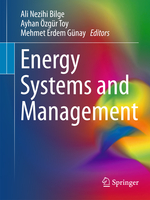Publications
Filter by type:
Energy systems and management ~ Chapter 18: Effect of curing time on poly(methacrylate) living polymer

Energy systems and management ~ Chapter 18: Effect of curing time on poly(methacrylate) living polymer
Self-healing materials increase the reliability and lifespan of the overall systems that they are incorporated to. This capacity of the material enhances the credibility of the in-flight health assessment in aerospace platforms. Such principles do not require visual or acoustic inspections to recover the damages that occur during flight. This reduces the energy requirements associated with maintenance, replacement of parts, and off-line time. Poly(methacrylate) (PMMA) living polymer mixed with nanoparticles possesses miraculous properties such as minimized gas permeability, improved heat resistance, and boosted physical performance. In this study, PMMA is synthesized by the atom transfer radical polymerization (ATRP) method and the mechanical properties of the material have been manipulated by changing the curing time. The effects of curing time on mechanical properties are examined by the stereomicroscope images and Shore D hardness tests satisfying ASTM D785 test standards.
Self-healing materials; Atom Transfer Radical Polymerization; PMMA; Living Polymerizations; Curing
Effect of curing ambient on poly(methacrylate) living polymer
Abstract
Poly (methacrylate) (PMMA) shows several advantageous properties such as exceptional optical clarity, high strength, superior dimensional stability and modest wettability. PMMA is derived by living polymerization with Atom Transfer Radical Polymerization (ATRP) method. The samples were cured at two different environments such as air and argon. The curing process of PMMA in the air was performed at the room temperature. PMMA samples were cut red under controlled inert argon atmosphere with tightly controlled 45 ° C. The effect of curing ambient to polymer morphology was evaluated, comparatively. The effect of curing ambient on structural difference is examined by using XRD analysis and stereomicroscope.
Production of microencapsulate glycidyl methacrylate with melamine formaldehyde resin shell materials
Abstract
Production of pmma via living polymerizatıon with ATRP method
Abstract
Poly(methyl methacrylate) (PMMA) is produced by living polymerization with Atom Transfer Radical Polymerization (ATRP) process. Bu4NBr and CuBr were added to an argon-purged tube. Methyl methacrylate (MMA) added into the tube, followed by Pentamethyldiethylenetriamine (PMDETA) injection into the mixture during the continous purge of argon to the tube. The mixture was magnetically stirred until the making the homogeneous solution. Ethyl 2-bromoisobutyrate (EbiB) was then added. The mixture has been degassed severely through glass frit with argon. External argon sources prevent the mixture from getting contact with the atmosphere. The tube was kept in an oil bath placed over a magnetic stirrer. The resultant polymer was a transparent solid exhibiting a light green color. The resultant polymer is poured into the silicon rubber mold under argon atmosphere inside a ATMOS bag. The resulting polymer cured under argon atmosphere. The surface micrographs of the produced ATRP generated Living Polymer PMMA are investigated for the un-break and of the broken specimen. The hardness test results are determined for living polymer PMMA is compatible with given data with the technical literature.
The details on optical properties of polymethylmethacrylate for the Use in offshore oil and gas sectors
Abstract
There is a potential application area of Polymethylmethacrylate (PMMA) polymer produced by ATRP method. The affected areas in the offshore oil and gas sectors can be identified using the validation of the optical characteristics of the sensors and monitoring devices containing the PMMA polymer. However, the technological challenges at the researchers in the oil and gas areas require examining the details in the optical properties of PMMA polymer. The production of PMMA polymer equipment with high clarity was performed to increase their operational efficiency according to the interest of the oil and gas industry. PMMA polymer modified optical properties seems a suitable candidate for the use of them at condition monitoring and subsurface sensors.
Preparation and Characterization of PMMA/MWCNT Nanocomposite
Abstract
Physical Properties of Poly(Methyl Methacrylate)/Graphene Nanoplatelets Nanocomposite
Abstract